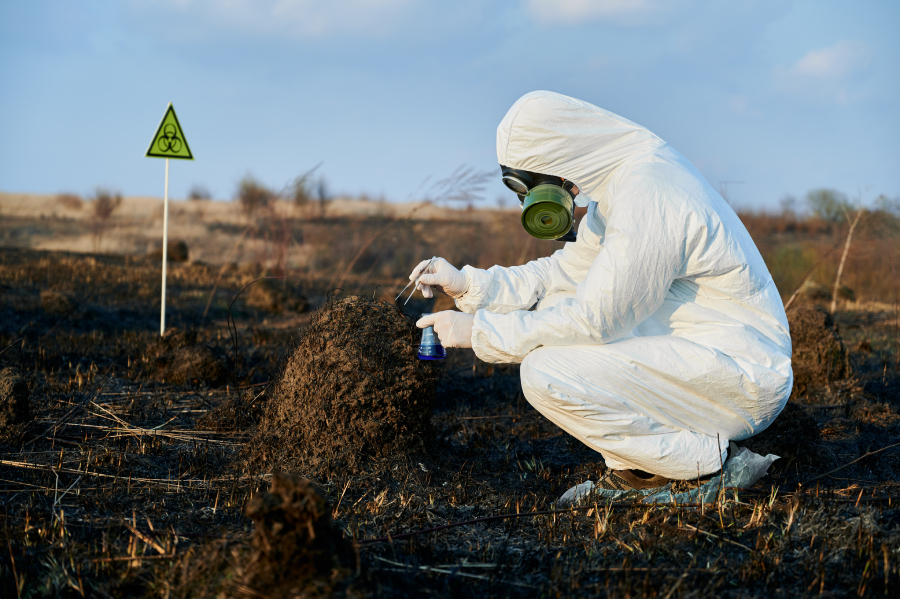When land or water becomes contaminated, the impacts ripple far beyond the site itself. Communities may lose access to clean water, ecosystems suffer, and redevelopment plans stall. Environmental remediation offers a way forward, combining engineering, science, and policy to repair the damage. But not all contamination is the same and neither are the cleanup strategies. From excavating polluted soils to using fungi that digest hydrocarbons, the types of environmental remediation reflect a wide spectrum of techniques, each suited to different challenges.
This guide looks at the most common and emerging environmental remediation methods and explains how they work in practice.

Physical Remediation Techniques
Physical remediation is often fast but can be expensive and disruptive to ecosystems, requiring close collaboration with fields like structural engineering and geotechnical engineering.
Excavation and Removal
- Contaminated soil is dug up and transported to an approved landfill or treatment facility.
- Effective for shallow, heavily polluted areas.
- Often combined with off-site treatment methods.
Dredging and Sediment Removal
- Used in rivers, lakes, and harbors where sediments are contaminated with heavy metals or hydrocarbons.
- Specialized equipment removes sediments for disposal or treatment.
Barrier Installation
- Physical barriers such as slurry walls, clay caps, or liners isolate contamination.
- Prevent pollutants from spreading into groundwater or nearby soils.
Physical remediation is often fast but can be expensive and disruptive to ecosystems.
Chemical Remediation Techniques
These remediation methods for contaminated sites are widely applied for organic chemicals and metals, showcasing the role of environmental engineering and the different types of environmental engineering in managing pollutants.
Chemical Oxidation
- Oxidizing agents (e.g., hydrogen peroxide, ozone, permanganate) are injected into contaminated soil or groundwater.
- Break down pollutants such as petroleum hydrocarbons or chlorinated solvents.
Chemical Reduction
- Reducing agents (e.g., zero-valent iron) transform contaminants into less toxic or mobile forms.
- Commonly used for chlorinated hydrocarbons and certain heavy metals.
Solidification/Stabilization
- Contaminants are mixed with binding agents like cement or lime.
- Immobilizes pollutants by trapping them within a solid matrix.
- Reduces leching potential and environmental mobility.
Biological Remediation Techniques
Biological remediation leverages natural organisms to break down or absorb contaminants. These methods are often more cost-effective and environmentally friendly than physical or chemical approaches. Biological techniques are slower but often sustainable and less disruptive.
Bioremediation
- Microorganisms metabolize contaminants into less harmful substances.
- Effective for petroleum hydrocarbons, solvents, and pesticides.
- Can be applied in-situ (on-site) or ex-situ (off-site treatment).
Phytoremediation
- Plants absorb, accumulate, or transform contaminants.
- Useful for heavy metals, nutrients, and organic compounds.
- Commonly used in green infrastructure and sustainable site cleanup.
Mycoremediation
- Fungi break down complex organic pollutants like petroleum hydrocarbons, pesticides, and even plastics.
- Relatively new but promising for sustainable cleanup.
Thermal Remediation Techniques
Thermal remediation uses heat to mobilize, volatilize, or destroy contaminants. These methods are effective for volatile organic compounds (VOCs) and semi-volatile contaminants. Thermal techniques are powerful but energy-intensive, making them best suited for severe contamination.
Thermal Desorption
- Contaminated soils are heated to release pollutants as vapors.
- Vapors are captured and treated with filters or combustion.
- Suitable for hydrocarbons, solvents, and pesticides.
In-Situ Thermal Treatment
- Heating elements or steam are applied underground to mobilize pollutants.
- Extracted vapors are treated above ground.
- Effective for sites where excavation is not feasible.

Emerging and Innovative Remediation Techniques
Advancements in science and technology have led to innovative environmental remediation methods designed for efficiency and sustainability.
Electrokinetic Remediation
- Low-level electric currents are applied to soil, moving charged contaminants toward electrodes for collection.
- Effective for heavy metals and organic pollutants in clay soils.
Nanoremediation
- Nanoparticles (e.g., nano zero-valent iron) are injected into contaminated groundwater.
- They react with pollutants, breaking them down rapidly.
- Promising but still under evaluation for large-scale use.
In-Situ Chemical Oxidation (ISCO)
- A targeted form of chemical oxidation applied directly underground.
- Rapidly destroys organic contaminants.
- Often combined with other methods for maximum effectiveness.
Combination and Integrated Remediation Approaches
No single method works for every contaminated site. Integrated remediation approaches combine techniques to achieve better results.
Hybrid Methods
- Example: Excavation combined with soil washing to remove and treat contaminated soils.
- Example: Bioremediation used after chemical oxidation to polish residual contamination.
Integrated Site Management
- Uses physical containment while applying in-situ chemical treatment.
- Incorporates monitoring systems for long-term risk reduction.
- Balances cost, effectiveness, and environmental impact.
By combining strategies, engineers can address multiple contaminants and site-specific conditions effectively
In-Situ vs. Ex-Situ Remediation Approaches
When discussing the types of remediation techniques, it’s also important to distinguish between in-situ and ex-situ approaches.
In-situ remediation takes place directly at the contaminated site without removing soil or groundwater. Examples include bioremediation, in-situ chemical oxidation, and electrokinetic remediation. The main advantage is reduced disturbance and lower costs, but effectiveness can be limited by site conditions such as soil permeability or contaminant depth.
Ex-situ remediation, on the other hand, involves removing contaminated material for treatment or disposal elsewhere. Excavation with off-site disposal, soil washing, and thermal desorption are common ex-situ methods. These techniques offer more control and faster results but are usually more disruptive and expensive.
Choosing between in-situ and ex-situ methods depends on factors like contaminant type, site accessibility, regulatory standards, and project timelines—considerations often identified during environmental site assessment phases or supported by wetland delineation.

Conclusion
So, what are the types of environmental remediation? They include physical, chemical, biological, thermal, and emerging methods, each with unique strengths and limitations.
Ultimately, the choice of environmental remediation methods depends on the contaminant type, site conditions, regulatory requirements, and project goals. Often, a combination of techniques provides the most effective solution.
By understanding the types of remediation techniques, communities, regulators, and engineers can work together to restore contaminated sites, protect ecosystems, and support sustainable development.
